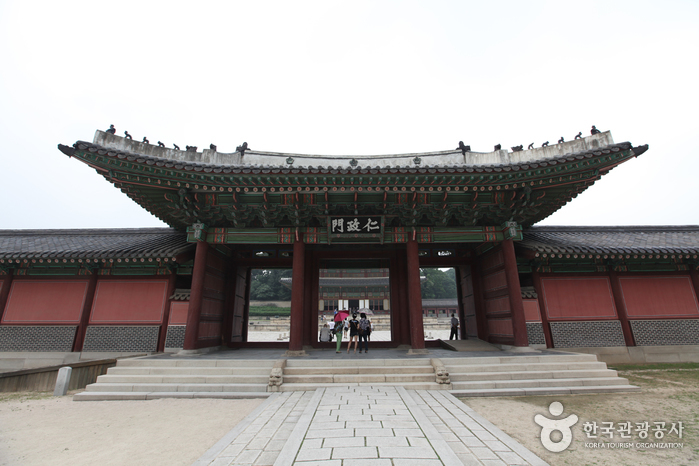Jayjun Plastic Surgery [Tax Refund Shop] (제이준성형외과)
4.9Km 2024-04-22
1F, 530, Nonhyeon-ro, Gangnam-gu, Seoul
-
Leather Craft Shop (손놀림공방)
4.9Km 2024-10-22
19-1 Naksanseonggwakseo 1-gil, Jongno-gu, Seoul
The leather workshop featured in the drama 'Boyfriend'
It is a leather workshop that appeared in the scene where Cha Soohyeon (Song Hyekyo) and Kim Jinhyeok (Park Bogum) reunite in the drama 'Boyfriend'. It is run by leather craft artist Kim Yeongae and is known for its many cute items. You can experience making leather knotted string bracelets and rings at a low cost.
Eye On Optical - Hanyang Univ. Branch [Tax Refund Shop] (아이온안경 한양대)
4.9Km 2024-04-17
#101, 30, Majo-ro, Seongdong-gu, Seoul
-
Gwanghwamun Gate (광화문)
4.9Km 2024-12-04
161 Sajik-ro, Jongno-gu, Seoul
+82-2-3700-3900
Built in 1395 under the reign of King Taejo, the first king of the Joseon dynasty, Gwanghwamun Gate is the southern gate of Gyeongbokgung Palace. It is also the main gate of the palace, therefore larger and fancier in comparison to the other gates. Gwanghwamun Gate consists of three arched gates; the center gate was used by the king, while the other two were used by the crown prince and royal officials. The tall granite walls of the gate serve as a platform for the wooden gate tower that watches over the city. The gate has a sign with its name written at the top center of the gate tower.
Gwanghwamun Gate went through several damages and restorations over the course of history. It was first severely damaged during the Imjin War (1592-1598) and was not restored until the reconstruction of Gyeongbokgung Palace in 1864. Under the Japanese administration, the gate was demolished and relocated to the north of the palace's eastern gate, followed by series of damages during the Korean War (1950-1953). In 1968, Gwanghwamun Gate was relocated back to the south of the palace and was rebuilt using concrete; however, the gate’s position was shifted a few meters away from its original location. In 2006, a major reconstruction project took place to restore Gwanghwamun Gate to its original state and location, disassembling the structure completely and replacing concrete with granite and wood. After three years and eight months of construction, Gwanghwamun Gate was fully restored to its original form and was open to the public on August 15, 2010.
Changdeokgung Injeongmun Gate (창덕궁 인정문)
4.9Km 2025-01-14
99, Yulgok-ro, Jongno-gu, Seoul
+82-2-3668-2300
Serving as the main gate of Injeongjeon Hall, Injeongmun Gate was established in 1405 (5th year of King Taejo’s reign during the Joseon dynasty). Later on, the gate was destroyed by multiple fires during the Imjin War (Japanese invasion of Korea in 1592), therefore current form of the establishment displays designs that are more often seen in the late 19th century's. In addition, a lot
of subsidary marks and buildings are removed from the original places and relocated passing the time, however, still remains to represent prestigious ambience.
Injeongmun Gate served as the place for several coronation ceremonies of kings, prince's succession of throne, and many other national affairs celebrated by the royal members who gathered and aligned around this gate.
Answer Plastic Surgery [Tax Refund Shop] (앤써성형외과)
4.9Km 2024-04-23
6F, 105, Teheran-ro, Gangnam-gu, Seoul
-
Gami Plastic Surgery [Tax Refund Shop] (가미성형외과)
4.9Km 2024-04-16
13F, 105, Teheran-ro, Gangnam-gu, Seoul
-
A Tower Pharmacy - Gangnam Station Branch [Tax Refund Shop] (A타워약국 강남역)
4.9Km 2024-04-18
1F, 105, Teheran-ro, Gangnam-gu, Seoul
-
Olive Young - Dongnimmun Branch [Tax Refund Shop] (올리브영 독립문)
4.9Km 2024-04-18
99, Songwol-gil, Jongno-gu, Seoul
-
Sungkok Art Museum (성곡미술관)
4.9Km 2021-02-10
42, Gyeonghuigung-gil, Jongno-gu, Seoul
+82-2-737-7650
Sungkok Art Museum was founded in 1995 by the Korean corporation Ssangyong to promote Korean art. The gallery offers a special exhibition featuring modern artworks of Korean artists, as well as competitions and sponsorships to develop Korean art. In addition to the main building, there is an annex, as well as a tea house and art shop.
![Jayjun Plastic Surgery [Tax Refund Shop] (제이준성형외과)](http://tong.visitkorea.or.kr/cms/resource/54/2879854_image2_1.jpg)

![Eye On Optical - Hanyang Univ. Branch [Tax Refund Shop] (아이온안경 한양대)](http://tong.visitkorea.or.kr/cms/resource/77/2878777_image2_1.jpg)

![Answer Plastic Surgery [Tax Refund Shop] (앤써성형외과)](http://tong.visitkorea.or.kr/cms/resource/41/2879841_image2_1.jpg)
![Gami Plastic Surgery [Tax Refund Shop] (가미성형외과)](http://tong.visitkorea.or.kr/cms/resource/44/2879844_image2_1.jpg)


 English
English
 한국어
한국어 日本語
日本語 中文(简体)
中文(简体) Deutsch
Deutsch Français
Français Español
Español Русский
Русский